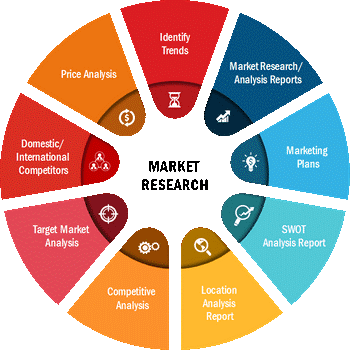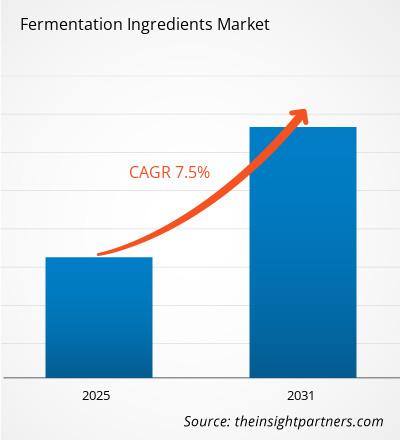発酵原料市場は 2021 年に 280 億米ドルを占め、米ドルを超えると予測されています2031年までに540億。 2022 年から 2031 年にかけて 7.5% の CAGR を記録すると推定されています。
発酵成分は食品や食品などの業界で使用されています。飲料、医薬品、動物飼料、パーソナルケア製品など。アミノ酸、有機酸、ビタミン、酵素、その他の発酵培養物の生成物や副産物は、最終製品の食感、味、色を変化させます。牛乳からのチーズの製造は、発酵成分の最も一般的な用途の 1 つであり、製品の保存期間の延長にも貢献します。
市場のダイナミクス
発酵原料の健康上の利点に対する意識の高まりと、肥満や消化器疾患の蔓延が発酵原料市場の成長を促進しています。これらの成分は、食品および飲料の製造業者に食品の保存のための便利なソリューションを提供します。さらに、それらは入手が容易です。発酵成分の需要はパーソナルケアおよび化粧品業界でも大幅に増加しています。
市場範囲
「 2031 年までの世界の発酵原料市場分析」は、専門的かつ専門的な分析です。市場動向分析に特に重点を置いた詳細な調査。このレポートは、詳細な市場分割とともに発酵原料市場の概要を提供することを目的としています。主要な市場プレーヤーのパフォーマンスに基づいて主要な市場統計を提供し、市場の主要な傾向と機会を強調します。
戦略的洞察
市場セグメンテーション
発酵原料市場は、種類と用途に基づいて分割されています。種類に基づいて、市場は酵母、アミノ酸、有機酸、ビタミン、酵素など。発酵原料市場は用途別に食品と発酵食品に分類されます。飲料、医薬品、動物飼料、パーソナルケアなど。
< strong>
このレポートは、業界の詳細を提供します。定性的および定量的な情報を含む概要。さまざまなセグメントに基づいた世界の発酵原料市場の概要と予測を提供します。また、北米、ヨーロッパ、アジア太平洋 (APAC)、中東およびアジアの 5 つの主要地域に関して、2021 年から 2031 年までの市場規模と予測推定も提供します。アフリカ (MEA)、および南アメリカ。各地域の発酵原料市場はそれぞれの国にサブセグメント化されています。このレポートでは、世界 18 か国の分析と予測、各地域に広がる現在の傾向と機会について取り上げています。
北米は、2021 年の発酵原料市場を独占しました。この地域の優位性は主に、主要国でのチーズ、ヨーグルト、アルコールの消費量の多さによって推進されています。さらに、パーソナルケアおよび化粧品業界における発酵原料の需要の増加が、この地域の市場成長に貢献しています。
次の図は、発酵原料市場の収益成長傾向を示しています。
< span style="font-size: 10pt; font-family: verdana, Geneva, sans-serif;">出典: Insight Partners 分析
このレポートは、発酵原料市場に影響を与える要因を需要側と供給側の両方から分析します。さらに、市場のダイナミクス、つまり、市場の進歩に影響を与える推進力、制約、機会、将来の傾向を評価します。このレポートでは、ポーターの市場に関する徹底的なポーターのファイブ フォース分析も提供しています。
新型コロナウイルス感染症のパンデミックの影響
期間中新型コロナウイルス感染症のパンデミックにより、発酵原料の供給が中断されたにもかかわらず、発酵原料の需要は比較的安定しており、その結果、世界中で不足状態に陥っていました。不足の主な原因は、サプライチェーンの混乱と、発酵原料に使用されるさまざまな原料の禁止令だった。また、旅行や貿易の禁止により原材料が不足し、これらの製品の生産や流通に影響があり、価格の上昇につながりました。発酵成分は主に食品や食品などのさまざまな用途に使用されています。飲料、医薬品、化粧品、パーソナルケア。パンデミックは厳格なロックダウンや製造工場の閉鎖によりこれらの産業の成長を妨げ、それにより発酵原料市場の成長を妨げました。しかし、2021 年以降、原料の入手可能性と食品、飲料、パーソナルケアなどの最終用途産業からの需要の増加により、発酵原料の生産が急増しました。
市場参加者
レポートでは、発酵原料市場における主要な有機および無機の成長戦略に焦点を当てています。市場関係者が採用する有機的な成長戦略には、製品の発売、製品の承認、特許やイベントが含まれます。さらに、市場で見られる無機的な成長戦略には、買収、パートナーシップ、コラボレーションが含まれます。これらの活動により、市場参加者のビジネスと顧客ベースの拡大への道が開かれました。
発酵原料市場に関するレポートは、SWOT分析と市場戦略に焦点を当てて、この市場の主要企業のプロフィールを示します。企業概要セクションでは、業界の主要企業に焦点を当て、提供されるコンポーネントやサービス、過去 3 年間の財務情報、過去 5 年間の主な開発などの情報を提供します。発酵原料市場に携わる数社のリストを以下に示します。
- Döhler GmbH
- DSM
- Chr.ハンセン ホールディング A/S
- ラレマンド社
- Kerry Group plc
- カーギル株式会社
- Associated British Foods plc
- ロンザ
- アシュランド
- AngelYeast Co., Ltd
The Insight Partner の専任の調査分析チームは、高度な統計専門知識を持つ経験豊富な専門家で構成されています。このチームは、既存の調査のさまざまなカスタマイズ オプションも提供しています。
- Historical Analysis (2 Years), Base Year, Forecast (7 Years) with CAGR
- PEST and SWOT Analysis
- Market Size Value / Volume - Global, Regional, Country
- Industry and Competitive Landscape
- Excel Dataset

Report Coverage
Revenue forecast, Company Analysis, Industry landscape, Growth factors, and Trends

Segment Covered
This text is related
to segments covered.

Regional Scope
North America, Europe, Asia Pacific, Middle East & Africa, South & Central America

Country Scope
This text is related
to country scope.
Trends and growth analysis reports related to Food and Beverages : READ MORE..
The List of Companies
1. E.I. Dupont De Nemours and Company
2. Ajinomoto Corporation Inc.
3. Koninklijke DSM N.V.
4. CHR. Hansen A/S
5. BASF SE
6. Lallemand Inc.
7. Angelyeast Co., Ltd.
8. Döhler Group
9. Cargill, Incorporated
10. Lonza
The Insight Partners performs research in 4 major stages: Data Collection & Secondary Research, Primary Research, Data Analysis and Data Triangulation & Final Review.
- Data Collection and Secondary Research:
As a market research and consulting firm operating from a decade, we have published and advised several client across the globe. First step for any study will start with an assessment of currently available data and insights from existing reports. Further, historical and current market information is collected from Investor Presentations, Annual Reports, SEC Filings, etc., and other information related to company’s performance and market positioning are gathered from Paid Databases (Factiva, Hoovers, and Reuters) and various other publications available in public domain.
Several associations trade associates, technical forums, institutes, societies and organization are accessed to gain technical as well as market related insights through their publications such as research papers, blogs and press releases related to the studies are referred to get cues about the market. Further, white papers, journals, magazines, and other news articles published in last 3 years are scrutinized and analyzed to understand the current market trends.
- Primary Research:
The primarily interview analysis comprise of data obtained from industry participants interview and answers to survey questions gathered by in-house primary team.
For primary research, interviews are conducted with industry experts/CEOs/Marketing Managers/VPs/Subject Matter Experts from both demand and supply side to get a 360-degree view of the market. The primary team conducts several interviews based on the complexity of the markets to understand the various market trends and dynamics which makes research more credible and precise.
A typical research interview fulfils the following functions:
- Provides first-hand information on the market size, market trends, growth trends, competitive landscape, and outlook
- Validates and strengthens in-house secondary research findings
- Develops the analysis team’s expertise and market understanding
Primary research involves email interactions and telephone interviews for each market, category, segment, and sub-segment across geographies. The participants who typically take part in such a process include, but are not limited to:
- Industry participants: VPs, business development managers, market intelligence managers and national sales managers
- Outside experts: Valuation experts, research analysts and key opinion leaders specializing in the electronics and semiconductor industry.
Below is the breakup of our primary respondents by company, designation, and region:

Once we receive the confirmation from primary research sources or primary respondents, we finalize the base year market estimation and forecast the data as per the macroeconomic and microeconomic factors assessed during data collection.
- Data Analysis:
Once data is validated through both secondary as well as primary respondents, we finalize the market estimations by hypothesis formulation and factor analysis at regional and country level.
- Macro-Economic Factor Analysis:
We analyse macroeconomic indicators such the gross domestic product (GDP), increase in the demand for goods and services across industries, technological advancement, regional economic growth, governmental policies, the influence of COVID-19, PEST analysis, and other aspects. This analysis aids in setting benchmarks for various nations/regions and approximating market splits. Additionally, the general trend of the aforementioned components aid in determining the market's development possibilities.
- Country Level Data:
Various factors that are especially aligned to the country are taken into account to determine the market size for a certain area and country, including the presence of vendors, such as headquarters and offices, the country's GDP, demand patterns, and industry growth. To comprehend the market dynamics for the nation, a number of growth variables, inhibitors, application areas, and current market trends are researched. The aforementioned elements aid in determining the country's overall market's growth potential.
- Company Profile:
The “Table of Contents” is formulated by listing and analyzing more than 25 - 30 companies operating in the market ecosystem across geographies. However, we profile only 10 companies as a standard practice in our syndicate reports. These 10 companies comprise leading, emerging, and regional players. Nonetheless, our analysis is not restricted to the 10 listed companies, we also analyze other companies present in the market to develop a holistic view and understand the prevailing trends. The “Company Profiles” section in the report covers key facts, business description, products & services, financial information, SWOT analysis, and key developments. The financial information presented is extracted from the annual reports and official documents of the publicly listed companies. Upon collecting the information for the sections of respective companies, we verify them via various primary sources and then compile the data in respective company profiles. The company level information helps us in deriving the base number as well as in forecasting the market size.
- Developing Base Number:
Aggregation of sales statistics (2020-2022) and macro-economic factor, and other secondary and primary research insights are utilized to arrive at base number and related market shares for 2022. The data gaps are identified in this step and relevant market data is analyzed, collected from paid primary interviews or databases. On finalizing the base year market size, forecasts are developed on the basis of macro-economic, industry and market growth factors and company level analysis.
- Data Triangulation and Final Review:
The market findings and base year market size calculations are validated from supply as well as demand side. Demand side validations are based on macro-economic factor analysis and benchmarks for respective regions and countries. In case of supply side validations, revenues of major companies are estimated (in case not available) based on industry benchmark, approximate number of employees, product portfolio, and primary interviews revenues are gathered. Further revenue from target product/service segment is assessed to avoid overshooting of market statistics. In case of heavy deviations between supply and demand side values, all thes steps are repeated to achieve synchronization.
We follow an iterative model, wherein we share our research findings with Subject Matter Experts (SME’s) and Key Opinion Leaders (KOLs) until consensus view of the market is not formulated – this model negates any drastic deviation in the opinions of experts. Only validated and universally acceptable research findings are quoted in our reports.
We have important check points that we use to validate our research findings – which we call – data triangulation, where we validate the information, we generate from secondary sources with primary interviews and then we re-validate with our internal data bases and Subject matter experts. This comprehensive model enables us to deliver high quality, reliable data in shortest possible time.



 Get Free Sample For
Get Free Sample For